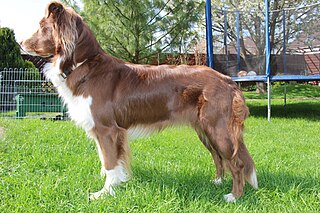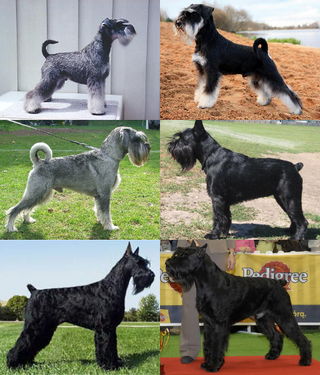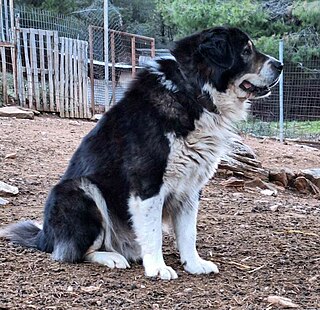
The Kooikerhondje is a small spaniel-type breed of dog of Dutch ancestry that was originally used as a working dog, particularly in an eendenkooi to lure ducks. Kooikers were popular in the 17th and 18th century and appear in paintings by Jan Steen.

The Catahoula Leopard Dog is an American dog breed named after Catahoula Parish, Louisiana. It became the state dog of Louisiana in 1979. It is recognized by the United Kennel Club under the name Louisiana Catahoula Leopard Dog, while the American Kennel Club Foundation Stock Service calls it Catahoula Leopard Dog. Both registries have assigned the breed a herding designation, although it has traditionally been used in hunting feral boars.

The Swedish Vallhund, also known as the Västgötaspets and Swedish cow dog, is a breed of dog native to Sweden. The breed's name, Vallhund, when translated into English, means herding dog, as the Swedish Vallhund was originally bred as a drover and herder of cows over 1,000 years ago. In 1942, the dog came close to extinction, but careful breeding and publicity by Swedish national Björn von Rosen and K. G. Zettersten managed to revive the breed in popularity and save it from its likely end. In 1943, the Swedish Kennel Club recognized the Swedish Vallhund as a breed, and officially categorized the Swedish Vallhund as "the Västgötaspets" for Västergötland, the province in which their revival took place. Since then, the breed has been recognized by, and bred in, over ten countries and has gained some popularity.

The Boxer is a medium to large, short-haired dog breed of mastiff-type, developed in Germany. The coat is smooth and tight-fitting; colors are fawn, brindled, or white, with or without white markings. Boxers are brachycephalic, have a square muzzle, mandibular prognathism, very strong jaws, and a powerful bite ideal for hanging on to large prey. The Boxer was bred from the Old English Bulldog and the now extinct Bullenbeisser, which became extinct by crossbreeding rather than by a decadence of the breed. The Boxer is a member of both The Kennel Club and American Kennel Club (AKC) Working Group.

The Chinook is a breed of sled dog, developed in the state of New Hampshire during the early 20th century. The Chinook is New Hampshire's official state dog.

The Australian Shepherd is a breed of herding dog from the United States. The name of the breed is technically a misnomer, as it was developed in California in the 19th century. It is believe to have its origins in sheepdog breeds from northwest Spain, as well as collies imported, alongside sheep, from Australia and New Zealand; the breed reportedly took its name from this trade. Originally used solely as a herding dog, the Australian Shepherd has become one of the most popular companion dog breeds in North America.

The Poodle, called the Pudel in German and the Caniche in French, is a breed of water dog. The breed is divided into four varieties based on size, the Standard Poodle, Medium Poodle, Miniature Poodle and Toy Poodle, although the Medium Poodle is not universally recognised. They have a distinctive thick, curly coat that comes in many colors and patterns, with only solid colors recognized by breed registries. Poodles are active and intelligent, and are particularly able to learn from humans. Poodles tend to live 10–18 years, with smaller varieties tending to live longer than larger ones.

The Smooth Collie is a breed of dog developed originally for herding. It is a short-coated version of the Rough Collie of Lassie fame. Some breed organisations consider the smooth-coat and rough-coat dogs to be variations of the same breed.

The Puli is a small-medium breed of Hungarian herding dog known for its long, corded coat. The tight curls of the coat appear similar to dreadlocks. A similar-looking, but much larger breed – also Hungarian – is the Komondor.

A Schnauzer is a dog breed type that originated in Germany from the 14th to 16th centuries. The term comes from the German word for "snout" and means colloquially "moustache", or "whiskered snout", because of the dog's distinctively bearded snout. Initially it was called Wire-Haired Pinscher, while Schnauzer was adopted in 1879.

The Black Russian Terrier, also known as the Chornyi Terrier, is a breed of dog created in USSR in Red Star Kennel during the late 1940s and the early 1950s for use as military/working dogs. At the present time, the Black Russian Terrier is a breed recognized by the FCI, AKC, CKC, KC, ANKC, NZKC and other cynological organizations. The contemporary Black Russian Terrier is a working dog, guarding dog, sporting and companion dog.

The Petit Basset Griffon Vendéen, or PBGV, is a breed of dog of the scent hound type, bred to trail hares in bramble-filled terrain of the Vendée district of France. The breed is known in the United States as "Petit" or "PBGV," in England as "Roughie," and in Denmark as "Griffon" or "Petit". The PBGV is one of six types of "basset"-type breeds recognised by the Fédération Cynologique Internationale (FCI).

The Finnish Lapphund is a hardy, easy going, medium-size breed of Spitz type. Traditionally it has been used for herding reindeer. Although it is one of the most popular dog breeds in its native country, Finland, it is not very numerous outside of the Nordic countries.

The Boykin Spaniel is a medium-sized breed of dog, a Spaniel bred for hunting wild turkeys and ducks in the Wateree River Swamp of South Carolina, in the United States. It is the state dog of South Carolina, where it was discovered and further developed by hunters in the early through mid 1900s. September 1 is Boykin Spaniel Day in South Carolina, originally established in 1984.

The Berger Picard or Picardy Shepherd, is a French herding dog originating in Picardy. These dogs nearly became extinct after both World War I and World War II and remain a rare breed.

Danish–Swedish farmdog is a breed of dog that has its origin in Denmark and southern Sweden, but has become popular all over Scandinavia. It is a native breed which has historically lived on farms in the eastern part of Denmark and southernmost part of Sweden, serving as a guard dog, rat catcher and hunting dog. The breed's soft and gentle temperament also makes them excellent companion dogs. There are some indications that the breed originates from the pinscher breeds and the British white hunting terriers.

The Bohemian Shepherd is an ancient sheep herding dog and watch dog originating from the Czech Republic. Since 2019, the Bohemian Shepherd has been provisionally recognized by the FCI and the AKC's Foundation Stock Service.

The Russian Toy is a very small breed of dog originally bred in Russia from the English Toy Terrier. There are two types of coats in the breed: smooth coat and long coat. The smooth-coated variety was previously known as the Russian Toy Terrier and long-coated as the Moscow Long-Haired Toy Terrier. Both were brought together under the same Russian Toy Terrier name in 1988 and the "Terrier" was dropped from the name when the breed was added in 2006 to the official list of breeds registered with the Fédération Cynologique Internationale and has been registered in the Foundation Stock Service of the American Kennel Club since 2008, allowed to compete in AKC companion events since 2010. The first official breed standard of the two varieties was written in 1966 in Russia.

The Miniature American Shepherd, frequently abbreviated MAS, is a small herding dog breed. The MAS is highly intelligent and biddable. The breed is often trained for dog sports such as herding, agility, obedience, canine freestyle, flyball, and others. The Miniature American Shepherd was recognised by the American Kennel Club (AKC) in 2015 and is the club's 186th breed. In September 2019, the Fédération Cynologique Internationale (FCI) officially accepted the breed.

The Greek Shepherd or Greek Sheepdog is a breed of livestock guardian dog from Greece. Thought to be ancient in origin, the Greek Shepherd is very closely related to livestock guardian dog breeds from neighbouring countries; it is believed that some dogs are simultaneously claimed to be other breeds as they migrate annually across national borders with the flocks they protect in search seasonal pastures.

























